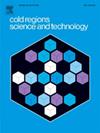The mechanical properties of gas-enriched sea ice
IF 3.8
2区 工程技术
Q1 ENGINEERING, CIVIL
引用次数: 0
Abstract
To investigate the mechanical properties of sea ice in the Arctic, ice blocks were collected using a ship crane and stored in a cold onboard storage unit during an Arctic expedition. During the transfer of ice blocks from the ship to the transport vehicle after docking, significant brine drainage occurred, artificially increasing the gas volume fraction within the ice. This unexpected shift allowed us to explore the mechanical properties of gas-enriched sea ice and the different impacts of gas and brine on sea ice strength. Examination of the ice crystal structure showed a granular ice layer at the top, underlain by a columnar ice layer. Sea ice samples were machined from the ice blocks for mechanical experiments performed in the laboratory. Three-point bending tests were conducted at ice temperatures of −12 to −3 °C, and uniaxial compressive strength tests were conducted at ice temperatures of −8 to −3 °C with a strain rate range of 10−6–10−2 s−1. Ice temperature, density, and salinity of each sample were measured to determine porosity. Results showed that both flexural strength and strain modulus of columnar sea ice exhibited statistically significant decreasing trends with increasing porosity. Flexural strength showed a significant correlation with gas volume fraction (R2 = 0.25, p > 0.1) but not with brine volume fraction (R2 = 0.37, p < 0.1). Conversely, strain modulus correlated significantly with brine volume fraction (R2 = 0.58, p < 0.1) but not with gas volume fraction (R2 = 0.06, p < 0.1). Uniaxial compressive strength decreased with increasing porosity and displayed a ductile-to-brittle transition, with strength initially increasing and then decreasing with rising strain rate. The transition strain rate ranged between 1.5 × 10−4 and 4.0 × 10−3 s−1 depending on ice crystal structure. Experimental results from gas-enriched sea ice were compared with previously reported data from natural sea ice (brine-dominated). At equivalent porosity levels, gas-enriched ice exhibited higher flexural strength and strain modulus than natural sea ice, indicating that brine has a stronger influence on bending mechanics than gas. However, the uniaxial compressive strength of gas-enriched ice remained comparable to that of natural sea ice.
富气海冰的力学特性
为了研究北极海冰的力学特性,在北极探险期间,用船吊收集冰块并将其储存在船上的冷储存装置中。在将冰块从船上转移到对接后的运输工具的过程中,发生了明显的盐水排放,人为地增加了冰内的气体体积分数。这种意想不到的转变使我们能够探索富含气体的海冰的力学特性,以及气体和盐水对海冰强度的不同影响。对冰晶结构的检查显示,顶部是粒状冰层,下面是柱状冰层。用冰块加工出海冰样本,在实验室进行力学实验。在- 12 ~ - 3℃冰温下进行三点弯曲试验,在- 8 ~ - 3℃冰温下进行单轴抗压强度试验,应变速率范围为10−6 ~ 10−2 s−1。测量每个样品的冰温、密度和盐度,以确定孔隙度。结果表明:随着孔隙率的增加,柱状海冰的抗折强度和应变模量均呈显著的下降趋势;抗折强度与气体体积分数呈显著相关(R2 = 0.25, p >;0.1),与盐水体积分数无关(R2 = 0.37, p <;0.1)。相反,应变模量与盐水体积分数显著相关(R2 = 0.58, p <;0.1),但与气体体积分数无关(R2 = 0.06, p <;0.1)。单轴抗压强度随孔隙率的增加而降低,呈现先升高后降低的韧脆性转变。根据冰晶结构的不同,转变应变速率在1.5 × 10−4 ~ 4.0 × 10−3 s−1之间。将富气海冰的实验结果与先前报道的天然海冰(以盐水为主)的数据进行了比较。在同等孔隙度条件下,富气冰的弯曲强度和应变模量均高于天然海冰,说明盐水对冰的弯曲力学影响强于气体。然而,富气冰的单轴抗压强度与天然海冰相当。
本文章由计算机程序翻译,如有差异,请以英文原文为准。
求助全文
约1分钟内获得全文
求助全文
来源期刊

Cold Regions Science and Technology
工程技术-地球科学综合
CiteScore
7.40
自引率
12.20%
发文量
209
审稿时长
4.9 months
期刊介绍:
Cold Regions Science and Technology is an international journal dealing with the science and technical problems of cold environments in both the polar regions and more temperate locations. It includes fundamental aspects of cryospheric sciences which have applications for cold regions problems as well as engineering topics which relate to the cryosphere.
Emphasis is given to applied science with broad coverage of the physical and mechanical aspects of ice (including glaciers and sea ice), snow and snow avalanches, ice-water systems, ice-bonded soils and permafrost.
Relevant aspects of Earth science, materials science, offshore and river ice engineering are also of primary interest. These include icing of ships and structures as well as trafficability in cold environments. Technological advances for cold regions in research, development, and engineering practice are relevant to the journal. Theoretical papers must include a detailed discussion of the potential application of the theory to address cold regions problems. The journal serves a wide range of specialists, providing a medium for interdisciplinary communication and a convenient source of reference.
 求助内容:
求助内容: 应助结果提醒方式:
应助结果提醒方式:


